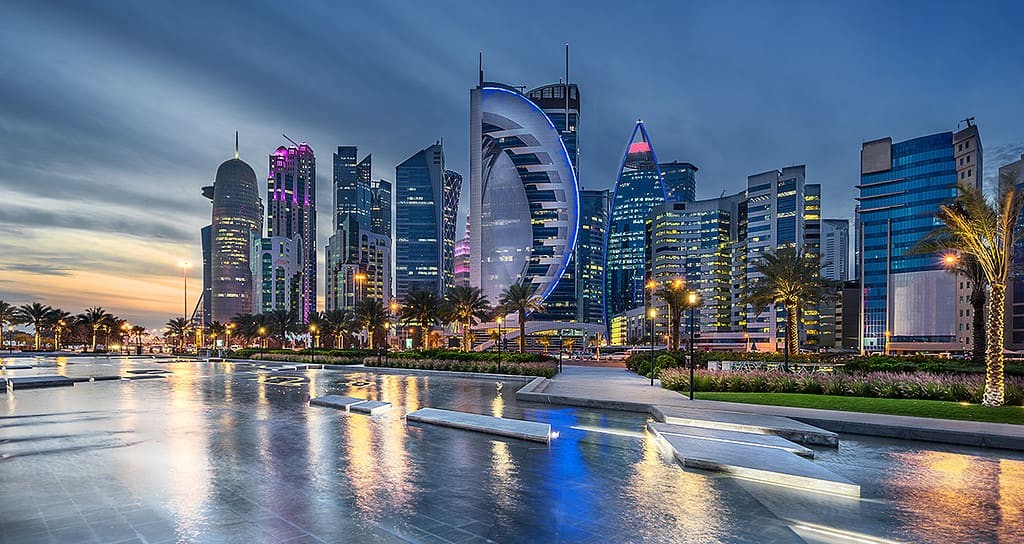When we talk about global wealth, certain images come to mind: bustling financial districts, luxury skylines, and perhaps, vast natural resources. Often, the countries that boast these images are not just wealthy, but also surprisingly small. Nations like Luxembourg, Singapore, and Switzerland consistently rank among the richest, leveraging sophisticated financial sectors or strategic industries. In the Middle East, Qatar stands out as a nation synonymous with immense wealth. But how rich is Qatar compared to other countries on a global scale?
To truly understand a country’s wealth, especially when making international comparisons, we need to move beyond simple Gross Domestic Product (GDP). While GDP reflects the total value of goods and services produced within a nation, it doesn’t tell us much about the prosperity of the average citizen, particularly in countries with vast populations. A more insightful metric is GDP per capita, which divides the total GDP by the number of residents. However, even GDP per capita needs further refinement to account for the actual cost of living and inflation rates in different countries. This is where Purchasing Power Parity (PPP) comes into play. GDP-PPP per capita, expressed in international dollars, provides a standardized measure that allows for a more accurate comparison of living standards across nations by considering the relative cost of goods and services.
So, using GDP-PPP per capita as our yardstick, let’s delve into understanding Qatar’s wealth in the context of the world’s richest countries and explore the factors that contribute to its economic standing.
Qatar’s Position Among the Wealthiest Nations
According to the latest data from the International Monetary Fund (IMF), Qatar consistently ranks among the top echelon of the world’s richest countries. In the most recent rankings, Qatar holds a prominent position, showcasing a GDP-PPP per capita that surpasses many developed nations.
 Modern skyscrapers and traditional Islamic architecture in Doha, Qatar
Modern skyscrapers and traditional Islamic architecture in Doha, Qatar
Currently, Qatar’s GDP-PPP per capita stands at $112,283. This figure places it firmly in the 5th position globally, according to the IMF’s April 2024 World Economic Outlook data. To put this into perspective, Qatar’s wealth per capita surpasses that of economic powerhouses like the United States, Switzerland, and Norway, all of which are featured in the top 10 richest countries.
Here’s how Qatar stacks up against some of the other wealthiest nations in the top 10:
- Luxembourg: The wealthiest nation, Luxembourg, boasts a GDP-PPP per capita of $143,743, leading Qatar by a significant margin. Luxembourg’s wealth is built on its robust financial sector and strategic location in Europe.
- Macao SAR: Known as the “Las Vegas of Asia,” Macao SAR has a GDP-PPP per capita of $134,141, driven by its thriving gambling and tourism industries.
- Ireland: With a GDP-PPP per capita of $133,895, Ireland benefits from being a major corporate tax haven, attracting multinational companies and boosting its economic figures.
- Singapore: A global financial and trade hub, Singapore’s GDP-PPP per capita is $133,737, reflecting its efficient economy and business-friendly environment.
- United Arab Emirates (UAE): Another oil-rich Gulf nation, the UAE, has a GDP-PPP per capita of $96,846, slightly below Qatar, but still exceptionally high globally.
- Switzerland: Famous for its banking, pharmaceuticals, and precision instruments, Switzerland’s GDP-PPP per capita is $91,932, demonstrating its strong and diversified economy.
- United States: The world’s largest economy, the United States, has a GDP-PPP per capita of $85,373, showcasing its immense economic output and relatively high standard of living.
- Norway: Benefiting from substantial oil reserves and a well-managed sovereign wealth fund, Norway’s GDP-PPP per capita is $82,832, emphasizing its sustainable economic model and low-income inequality.
While Qatar doesn’t top the list, its 5th position clearly indicates that it is among the most affluent countries in the world, far richer than most nations and comparable in wealth to other leading economies.
Factors Fueling Qatar’s Economic Prosperity
Several key factors have contributed to Qatar’s remarkable wealth and its high ranking compared to other countries:
-
Hydrocarbon Reserves: Qatar’s economic engine is primarily powered by its massive reserves of oil and natural gas. It holds some of the world’s largest natural gas reserves and is a leading exporter of liquefied natural gas (LNG). The revenue generated from these resources has been the cornerstone of Qatar’s wealth accumulation for decades.
-
Small Population: Qatar’s population is relatively small, around 3 million people, with a significant portion being expatriate workers. This small national population, combined with vast hydrocarbon wealth, dramatically inflates the GDP per capita figures. When wealth is distributed across a smaller population, the average per capita income naturally appears higher.
-
Strategic Investments: Qatar has strategically invested its hydrocarbon wealth both domestically and internationally. The Qatar Investment Authority (QIA), the country’s sovereign wealth fund, holds significant stakes in global companies and assets, diversifying its income streams and ensuring long-term financial stability.
-
Economic Diversification Efforts: While heavily reliant on hydrocarbons, Qatar has been actively pursuing economic diversification to reduce its dependence on oil and gas revenues. Investments in sectors like tourism, finance, real estate, and education are aimed at creating a more sustainable and diverse economy for the future.
-
Modern Infrastructure and Development: Qatar has invested heavily in developing state-of-the-art infrastructure, including world-class airports, ports, and urban centers. This modernization has attracted international businesses, facilitated trade, and improved the quality of life for its residents, further contributing to economic growth.
Nuances in Wealth and Challenges for Qatar
It’s important to acknowledge the nuances when interpreting wealth rankings based on GDP-PPP per capita. While these figures provide a valuable comparative measure, they represent averages and may not fully reflect the distribution of wealth within a country.
-
Income Inequality: Like many wealthy nations, Qatar faces the challenge of income inequality. While the GDP-PPP per capita is high, a significant portion of the population consists of lower-income migrant workers who may not experience the same level of prosperity as Qatari nationals. This disparity is a critical factor to consider when assessing the overall well-being of the entire population.
-
Economic Volatility: Despite diversification efforts, Qatar’s economy remains susceptible to fluctuations in global energy prices. Downturns in oil and gas markets can impact government revenues and economic growth, highlighting the need for continued diversification and fiscal prudence.
-
Geopolitical Factors: The Middle East region is often subject to geopolitical instability, which can pose risks to Qatar’s economic stability. Regional conflicts, trade disruptions, and political tensions can all have implications for Qatar’s economy and its standing in the global wealth landscape.
Conclusion: Qatar’s Rich Standing in the World
In conclusion, when considering how rich is Qatar compared to other countries, the data clearly indicates that Qatar is one of the wealthiest nations on Earth. Its high GDP-PPP per capita, driven by vast hydrocarbon resources and a small population, places it among the top 5 globally, surpassing many developed economies. While wealth distribution and economic diversification remain ongoing considerations, Qatar’s economic prosperity is undeniable. The nation’s strategic investments, modern infrastructure, and efforts to diversify its economy suggest a commitment to maintaining its high standard of living and global economic prominence in the years to come.
This analysis demonstrates that Qatar’s wealth is not just a matter of perception, but a reality backed by economic data and significant resource endowments. As global economic landscapes evolve, Qatar’s ability to adapt and further diversify will be crucial in sustaining its position among the world’s richest countries.
